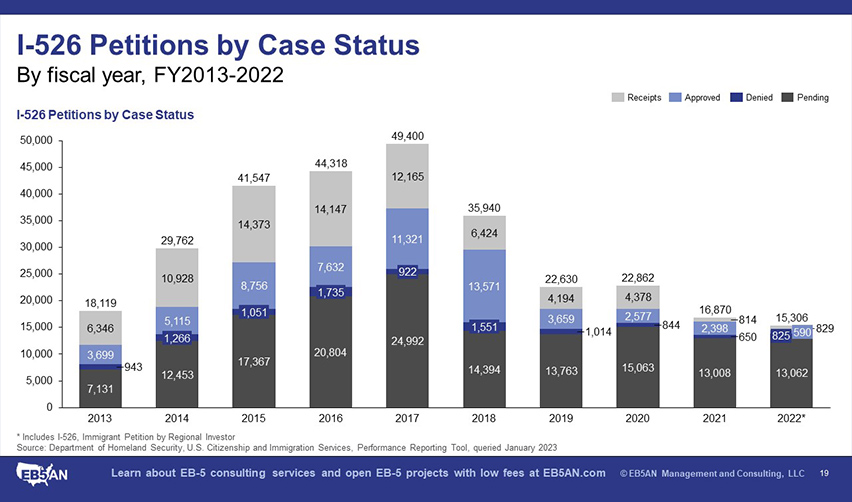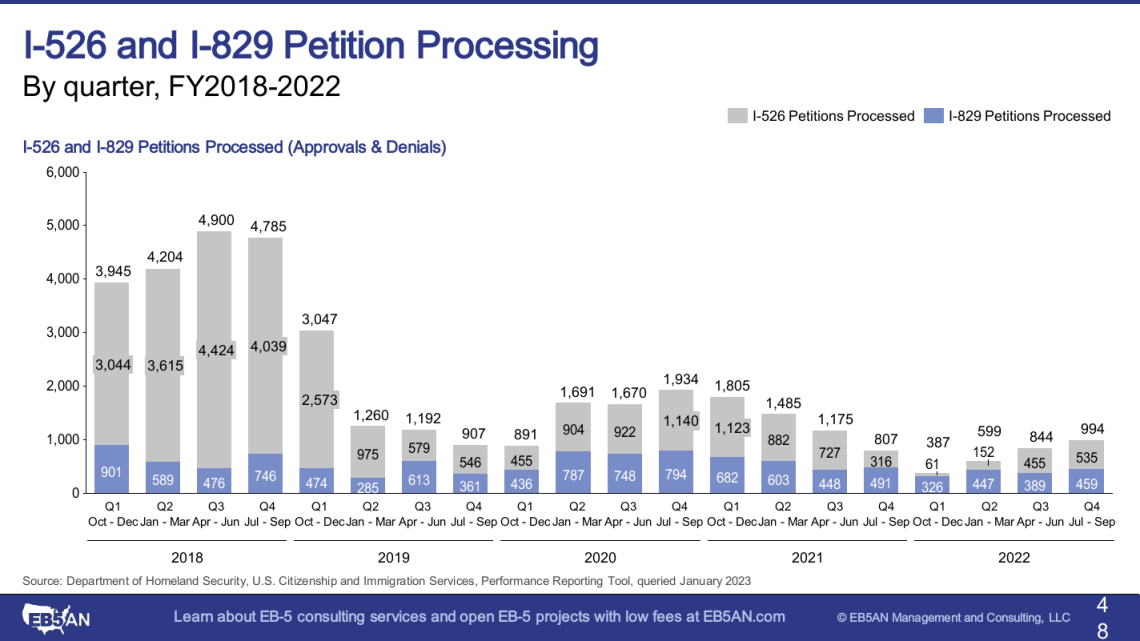United States Citizenship and Immigration Services (USCIS) has released processing data for EB-5 visa petitions through FY2022 Q4. The data include the filings, approvals, denials, and pending cases of Form I-526 (including the new I-526E petition for regional center investors) and Form I-829.
These statistics reflect many of the recent events that have impacted the demand for EB-5 immigration, including the following.
- The COVID-19 pandemic significantly reduced the demand for EB-5 immigration in the 2020 and 2021 fiscal years.
- The minimum investment amount for the EB-5 visas was lowered to only $500,000 from June 2021 to March 2022, making EB-5 immigration more accessible.
- The EB-5 Regional Center Program expired in June 2021, and regional centers were unable to resume operations until June 2022. The regional center program is the main investment vehicle for EB-5 visa applicants.
- The EB-5 Reform and Integrity Act (RIA) was signed into law in March 2022. While the RIA introduced stringent new requirements for EB-5 regional centers and project managers, USCIS initially released very limited guidelines for compliance.
Download EB5AN’s analysis slides for a comprehensive breakdown of the FY2022 Q4 data, and continue reading for detailed analysis and key takeaways.
Download EB5AN Analysis Slides on I-526 and I-829 Processing Statistics
Data from I-526 Petitions
Data from I-829 Petitions
Forms I-526 and I-829 Processing Data Comparison
Possible Trends in FY2023
Data from I-526 Petitions
Both filings and USCIS adjudications of Form I-526 decreased in FY2022.
Receipts
Receipts, or new filings, of Form I-526 have steadily declined since FY2021, with only 829 filings in FY2022. This is a significant decrease compared to the 4,378 filings in FY2020 and represents only a slight increase from 814 filings in FY2021.
The COVID-19 pandemic and the higher EB-5 investment amount of $800,000 established by the RIA are the main contributing factors to this trend. USCIS’s failure to provide guidance to regional centers for the first few months after the RIA was passed have also generated uncertainty and, very likely, reduced demand for EB-5 immigration.
Receipts in FY2022 Q4
At the quarterly level, the number of I-526 receipts has generally fluctuated since FY2021 Q4 and particularly in FY 2022. While FY2022 Q4 saw 188 filings, the second and third quarters saw 420 and 32 filings, respectively.
While FY2022 Q4 saw a significant increase in filings from Q3, the overall filing volume remains historically low. The volume of receipts may, however, grow in the next quarters thanks to USCIS’s more specific guidance for regional centers released throughout the second half of 2022.
Denials and Approvals
After reaching 266 in FY2021 Q4, I-526 petition denials decreased to only 45 in FY2022 Q1 and then steadily increased throughout the year to reach 276 in Q4.
FY2022 Q4 saw 535 total adjudications of Form I-526. The overall number of adjudications started to decrease somewhat in FY2019 and then experienced a major drop after FY2020. At the same time, the number of I-526 receipts also dropped after FY2020, thus exposing USCIS’s limited processing capacity.
I-526 Petition Summary
USCIS has been unable to cut down the backlog of pending I-526 petitions, as FY2022 saw 13,062 pending applications compared to FY2021’s backlog of 13,008. This represents a backlog growth rate of 0.4%.
In a recent press release, USCIS indicated that its limited processing capacity has largely been caused by the lower volume of petition filings since 2020; 96% of the agency’s funding comes from petition filing fees. This has, in turn, left USCIS with staffing shortages.
In total, 829 I-526 petitions were filed in FY2022 and 1,415 were adjudicated.
Data from I-829 Petitions
FY2022 processing data for Form I-829 reflects the lower volume of both filings and adjudications of Form I-526.
Receipts
I-829 receipts have declined from 1,249 in FY2021 Q3 to only 69 in FY2022 Q4. This is the lowest quarterly I-829 receipt volume since at least FY2013 Q1.
At the yearly level, the 2020 and 2021 fiscal years saw I-829 receipts of 3,096 and 3,301. Still, the pandemic-induced drop in demand is now apparent in FY2022 processing data, with only 1,270 receipts. This represents a year-on-year growth rate of -62% and the lowest receipt volume since FY2013.
Denials and Approvals
Quarterly denials have remained at roughly the same levels, as FY2022 Q4 saw an I-829 denial rate of 9%.
Approval rates have similarly remained consistent for Form I-829, at 95%, 91%, and 90% for the 2020, 2021, and 2022 fiscal years, respectively.
In total, 1,270 I-829 petitions were filed in FY2022, and 1,621 were adjudicated.
I-829 Petition Summary
Much like the I-526 backlog, the number of pending I-829 petitions has stayed roughly the same: 11,448 in FY2021 and 11,150 in FY2022. This represents a year-on-year growth rate of only -3%.
Forms I-526 and I-829 Processing Data Comparison
In FY2022, 1,415 I-526 petitions were adjudicated, and 1,621 I-829 forms were adjudicated. 829 I-526s petitions were filed, and 1,270 I-829s were filed.
USCIS has yet to reduce the substantial backlogs for both petitions.
Possible Trends in FY2023
The stagnant backlogs for both petitions, compounded with lower receipt volumes, highlight USCIS’s processing inefficiency.
Petition receipt volumes may improve now that USCIS has released several new RIA-specific forms and further guidance for regional centers. As more EB-5 investment opportunities are structured under the RIA, demand for the visa may experience a resurgence.
Imminent Fee Increases for EB-5 Petitions
As mentioned previously, USCIS has indicated that its lack of funding from petition filing fees has impaired its ability to reduce the processing backlogs. The agency is now considering action to expand its processing resources.
On January 3, 2023, USCIS issued a notice of proposed rulemaking to adjust the filing fees for many of its applications, including the EB-5 immigrant petitions and the applications for regional center designation. This measure would raise the filing fee for Form I-526 from $3,675 to $11,160—a 204% increase. Form I-829 filing fee would be adjusted from $3,835 to $9,525 in a 148% increase.
If USCIS follows through on these proposed fee increases, the total filing fee amount for the EB-5 process will total $20,685. While this could be a useful funding source for USCIS to increase its processing capacity, it may also have the effect of dissuading potential EB-5 investors due to the high upfront costs. This scenario would mean that the existing backlog of petitions may be reduced, but receipt volumes would remain low.
USCIS is expected to adjust its filing fees after March 6, 2023. The processing data for Q3 2023 will shed light on how this measure will impact demand for EB-5 immigration and the volume of pending petitions.























